Erika Mailman's Blog, page 7
February 17, 2017
Research notebooks
Yep, four notebooks filled to the gills with research and scene outlining and all that jazz.

And here are some pages I discarded. I was lying in bed on a rainy day and throwing them off the end. I've gotten to the point that there's so much information in there that I have to cull out stuff I've already used so it's easier to find the things I want to put my hands on. I use post-it notes on the sides to draw my attention to certain pages, like "Brooke facts"- a page where all the dates and facts on one character are found.

. . . .

And here are some pages I discarded. I was lying in bed on a rainy day and throwing them off the end. I've gotten to the point that there's so much information in there that I have to cull out stuff I've already used so it's easier to find the things I want to put my hands on. I use post-it notes on the sides to draw my attention to certain pages, like "Brooke facts"- a page where all the dates and facts on one character are found.

. . . .
Published on February 17, 2017 12:51
January 23, 2017
Dost hear that, yolk devils? My review of The Witch
 Thomasin and Caleb at the brook
Thomasin and Caleb at the brook*** quite atrocious spoilers be found in this review ***
My sister was here visiting the week before Christmas, and we decided to do the very Victorian thing of indulging in a ghost story for the holidays. The idea of the movie The Witch appealed greatly to us. We are the descendants of Mary Bliss Parsons, who faced trial for witchcraft in Massachusetts in 1656 and again in 1674, decades before the Salem hysteria. She was found innocent both times. I'm also the author of The Witch's Trinity, a novel about medieval witchcraft—in fact, it was uncannily during the course of writing the novel that my mother learned of our connection to Mary Bliss Parsons.
We settled down to watch while my husband settled the kids to bed. We kept the sound low to not drift up to them, and I'll readily admit we have an elderly television, but even so it was astonishing how much of the movie we could not hear.
As in, we basically could have turned the sound off and gotten roughly the same amount of information.
It is not an exaggeration to say it was as if we watched a silent film with some atmospheric music and a bit of dialogue here and there.
We would periodically pause the movie and confer with each other about what we'd gleaned, like archeologists trying to reconstruct a pot out of potsherds. A typical exchange:
Sister: So, the mom thinks Thomasina stole her silver cup.Me: Oh! Wow. I totally didn't get that.
We thought her name was Thomasina throughout the whole movie because we just couldn't hear.
Although I'm sure in real life, the actor who plays the father is considered to have a majestic voice, in this setting it registered as Grendel with a head cold.
The visuals were splendid enough to keep us going although I did ask my sister if she wanted to continue and she kind of shrugged. As the movie came to a close and the screen blacked out, I said to her, "If the credits start to roll now, I'm going to give the finger to the screen." The credits rolled, and I flipped the bird.
"That was pretty bad," she said. I felt doubly guilty because the night before, my husband had inflicted The Great Muppet Caper Movie on all of us.
She went to bed disgruntled, and I went to imdb and wikipedia to figure out what the heck we'd missed.
It turned out: a lot. Funnily enough, the dialogue actually was an important conveyor of plot!
I told her in the morning what I'd learned and we both decided we'd like to watch it again sometime with closed captioning turned on.
Part Two
Fast forward a few weeks. I watched the movie again on Friday the 13th (of January) with captions turned on. I watched on my Kindle screen in bed.
The movie vastly improved, but still feels like it didn't accomplish everything it might've. As a person whose creative work is reviewed online, I know how much a review can sting (right now on Amazon, the first review in the queue for one of my novels is one-star and says nothing more than "Awful"). So I apologize in advance, and will add that I feel the acting in this movie was superb. Every single actor was riveting, credible. The cinematography was incredible, the costuming and sets powerful, I'm not sure how to judge directing, but that seemed very well done too! I think the weak link here was the script.
Things the script did right:Authentically conveyed the language of people newly arrived from England to the New WorldCreated timed suspense over secrets family members had been keeping from each other (the precious cup, the idea of placing Thomasin with another family)Authentically conveyed a family working together to create subsistence in a harsh environment
Things the script could've done better:Created more horror.
When I think about narrative arc, it's about introducing trouble, which builds and builds until some climactic event happens. In this movie, the worst thing that happens takes place in the first eight minutes.
Where do we go from there? There's quite literally nothing worse than that old woman using her child-sized mortar and pestle. Or the way her hands travel over his naked body (disturbing on multiple levels) before the knife glints in the shot.
Worse, we know right away that there are witches. This is not a story the baby comes back and tells the family—we see it as "objective" observers, and thus it must be true and must be happening.
I was thinking, what if the two abductions of the story were reversed? Caleb disappears first, and we can still see the transformed woman beckoning him into her embrace, but we can wonder if he is really seeing what he thinks he is. It would create a helpful ambiguity. Maybe he's eaten ergot bread or is growing into mental imbalance as well as puberty...
Then, if the baby disappeared after Caleb, we would have some sort of reference point for what we feared would happen to him: and then what really does would leave us far more shocked and upset.
And by the way, the shot of the seductive woman embracing Caleb: it was unclear to me whether the crone's arm that grabs him was her arm or that of someone standing behind her. If the former, the angle was a little off somehow.
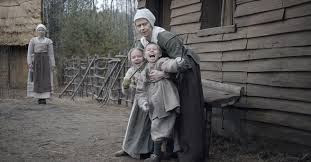 Mother and twins, Thomasin in the background
Mother and twins, Thomasin in the backgroundQuestions the movie didn't answer for me even upon two viewings:1. Did the family come across an already-existing farm or build one? They first survey an empty field in front of the "evil tree" but when we next see the complex, the viewpoint has changed, so it's unclear whether it was built on the same stretch of land. If the farm was already built, there's some instant backstory about whether this evil property continues a cycle of luring in settlers. But (thinking aloud here), I think the plantation in the beginning that expels them must've been Plimouth, and therefore there probably weren't too many other folks preceding them into the wilderness.
2. What is the thinking with that tree? Source of power? Source of broomsticks? It features menacingly in several shots, but we don't learn why it is a "featured" tree.
3. What happened to the twins? At the end, the shed has been ripped apart and the two goats (other than Black Philip) lie half-eaten. I don't know if the children were abducted like Caleb was (for what purpose, then?) or like the baby was (aren't they too old to be flying ointment material?). I wondered if Thomasin would find them at the witch's cabal but it looked to be only grown women there.
4. Why would Thomasin accept the offer of an entity that killed everyone in her family? I'd need to see some proof of that "living deliciously" because it kind of seemed like the witch (es?) lived in a nasty little hovel.
I liked thinking about what would have happened if the mother had succeeded in strangling Thomasin. Would she then be offered the book to sign and the chance to join the cabal in the woods? I assume, though, that Thomasin was selected because of her beauty and nubility.
Continuity: We never see Thomasin clean her face but when she awakes there is no blood around her mouth, only on her neck and chest.
This movie takes all the ignorant, superstitious things people believed about witches back then and made them true. I'm sure some women and men who faced the noose or the stake are spinning in their graves right now.
I didn't find the movie scary but I found it somewhat haunting; it's a compliment that I wanted to watch it a second time. I loved its promise, and I wish it could've offered a stronger build-up of tension and mounting horror.
The title of my post comes from movie dialogue: I thought it was pretty awesome. That's what the father calls the twins when he suspects they may be witches.
. . . .
Published on January 23, 2017 12:36
January 14, 2017
Five Interesting Facts about Lizzie Borden
 Lizzie on the left, Chloe Sevigny on the right
Lizzie on the left, Chloe Sevigny on the right1. She was very active in the church.
An avid volunteer at the First Congregational Church, Lizzie served on the Ladies' Fruit & Flower Mission (organized to take fruit and flowers to sick people in hospitals or at home) and the Women's Christian Temperance Union (anti-alcohol). She also taught Sunday School, including to young Chinese boys who were the sons of immigrants. Is it any wonder the jury had a hard time seeing this diligently benevolent woman as a murderer? It must've been a long con.

2. She had a taste of the good life.
Two years before the brutal murders of her father and stepmother, Lizzie took a "Grand Tour" of Europe with some distant cousins. She was gone for a full 19 weeks, from June 21 to November 1 of 1890. Probably a wonderful time in which the household in Fall River took a few, calming deep breaths, while she witnessed the wonders of the Continent and the British/Irish isles. Lizzie's scrapbook of this visit, replete with photographs pasted in and her careful writing beneath, still exists in the archives of the Fall River Historical Society. Of course, it must've been difficult to settle back into her narrow life when she returned: no more of the grandeur of museums and statuary.
 April 1912 (22 years after Lizzie was there). Trivia: what big event happened in April 1912?
April 1912 (22 years after Lizzie was there). Trivia: what big event happened in April 1912? See below for chance to enter!
3. She was bossy.
Multiple accounts exist of her being proud, haughty, and willing to speak her mind. Once she returned from the Grand Tour, she had so many souvenirs and gew-gaws to display, that she and her older sister Emma swapped bedrooms. It's important to note that one larger bedroom funneled into a smaller one—almost as if the second bedroom were a closet to the first. Lizzie had traditionally slept in the smaller room, but somehow a change was effected after her return. Did Emma offer, or did Lizzie demand?
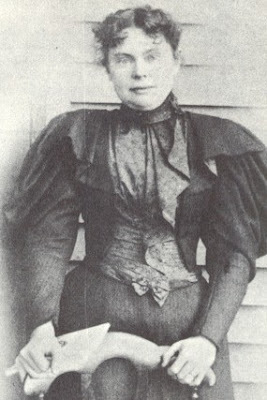 Gimme your room! And this chair!
Gimme your room! And this chair!4. She loved animals.
The largest bequest in Lizzie's will was to the Fall River Animal Rescue League ($30,000 in 1927 dollars!). She was known to love and cherish the pets she had after the murders; there is no mention of pets beforehand. Was part of the "problem" that she wasn't allowed to keep a dog in the house? Lizzie ordered expensive, carved tombstones for her dogs. And of course: the pigeons. Lizzie kept pet pigeons in the family barn. Two months before the murders, her father killed them all because neighbor boys had been breaking into the barn to mess with them. Apparently, her father hadn't understood the sentimental value and care she lavished on them (or did he?) Was the pigeon slaughter just one more straw that was put upon the proverbial camel's back?
 No...don't...it hurts... [from thriveumc.org]
No...don't...it hurts... [from thriveumc.org]5. It is possible she tried to poison the family.
Eli Bence, a druggist in Fall River, tried to testify that he had seen Lizzie try to purchase prussic acid (click link for more on this), but his information was suppressed during the trial. When was she trying to buy this poison, more commonly known as cyanide? Oh...just THE DAY BEFORE THE MURDERS.
In writing The Murderer's Maid (publishing in October 2017, my novel about Lizzie Borden from the maid's point of view), I had to decide how to tackle this sticky issue. Did she really try to purchase poison? Why did the judges (three of them!) decide the jury shouldn't hear Bence's testimony? And isn't it interesting that in the days before the murders, the entire household was vomiting, and Mrs. Borden even told the doctor she thought someone was trying to poison them?
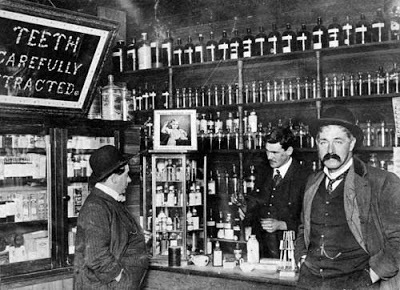 Typical drugstore of the era
Typical drugstore of the eraI get tense just typing all this, want to go back in time and throttle the judges! Ha ha. This is when history is at its best, when our emotions get caught up in it. I'll have a cover for The Murderer's Maid to share soon. In the meantime, if you love history like I do, I have several historical novels to share with you:
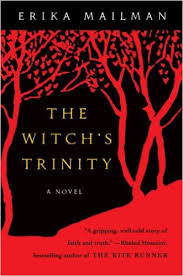
A medieval German woman is accused of witchcraft by her own daughter-in-law. "A well-constructed novel and a gripping, well-told story of faith and truth." —Khaled Hosseini, international bestselling author of The Kite Runner“Beautifully written, nary a word out of place, and with a few moments that throw you beyond—the way good books do.”
—San Francisco Chronicle
A San Francisco Chronicle Notable Book of 2007
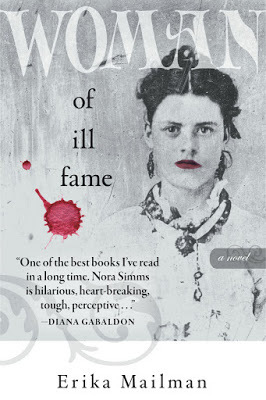
A Boston prostitute shows up in San Francisco at the very beginnings of the Gold Rush, and quickly learns she's in dangerous territory with a killer targeting her kind."LOVED Woman of Ill Fame! Nora Simms is hilarious, heartbreaking, tough, perceptive...
and one of the most engaging characters I've ever met between the pages of a book." —Diana Gabaldon, author of Outlander, now a Starz miniseries"Mailman serves up vivid description, sparkling prose and a Gold Rush prostitute as scrappy as Scarlett O’Hara." —Oakland Tribune
The giveaway is over. The winner was Chris V.: congratulations!
The big event in April 1912 was the sinking of the Titanic.
. . . . .
Published on January 14, 2017 13:41
Five Interesting Facts about Lizzie Borden plus a GIVEAWAY
 Lizzie on the left, Chloe Sevigny on the right
Lizzie on the left, Chloe Sevigny on the right1. She was very active in the church.
An avid volunteer at the First Congregational Church, Lizzie served on the Ladies' Fruit & Flower Mission (organized to take fruit and flowers to sick people in hospitals or at home) and the Women's Christian Temperance Union (anti-alcohol). She also taught Sunday School, including to young Chinese boys who were the sons of immigrants. Is it any wonder the jury had a hard time seeing this diligently benevolent woman as a murderer? It must've been a long con.

2. She had a taste of the good life.
Two years before the brutal murders of her father and stepmother, Lizzie took a "Grand Tour" of Europe with some distant cousins. She was gone for a full 19 weeks, from June 21 to November 1 of 1890. Probably a wonderful time in which the household in Fall River took a few, calming deep breaths, while she witnessed the wonders of the Continent and the British/Irish isles. Lizzie's scrapbook of this visit, replete with photographs pasted in and her careful writing beneath, still exists in the archives of the Fall River Historical Society. Of course, it must've been difficult to settle back into her narrow life when she returned: no more of the grandeur of museums and statuary.
 April 1912 (22 years after Lizzie was there). Trivia: what big event happened in April 1912?
April 1912 (22 years after Lizzie was there). Trivia: what big event happened in April 1912? See below for chance to enter!
3. She was bossy.
Multiple accounts exist of her being proud, haughty, and willing to speak her mind. Once she returned from the Grand Tour, she had so many souvenirs and gew-gaws to display, that she and her older sister Emma swapped bedrooms. It's important to note that one larger bedroom funneled into a smaller one—almost as if the second bedroom were a closet to the first. Lizzie had traditionally slept in the smaller room, but somehow a change was effected after her return. Did Emma offer, or did Lizzie demand?
 Gimme your room! And this chair!
Gimme your room! And this chair!4. She loved animals.
The largest bequest in Lizzie's will was to the Fall River Animal Rescue League ($30,000 in 1927 dollars!). She was known to love and cherish the pets she had after the murders; there is no mention of pets beforehand. Was part of the "problem" that she wasn't allowed to keep a dog in the house? Lizzie ordered expensive, carved tombstones for her dogs. And of course: the pigeons. Lizzie kept pet pigeons in the family barn. Two months before the murders, her father killed them all because neighbor boys had been breaking into the barn to mess with them. Apparently, her father hadn't understood the sentimental value and care she lavished on them (or did he?) Was the pigeon slaughter just one more straw that was put upon the proverbial camel's back?
 No...don't...it hurts... [from thriveumc.org]
No...don't...it hurts... [from thriveumc.org]5. It is possible she tried to poison the family.
Eli Bence, a druggist in Fall River, tried to testify that he had seen Lizzie try to purchase prussic acid (click link for more on this), but his information was suppressed during the trial. When was she trying to buy this poison, more commonly known as cyanide? Oh...just THE DAY BEFORE THE MURDERS.
In writing The Murderer's Maid (publishing in October 2017, my novel about Lizzie Borden from the maid's point of view), I had to decide how to tackle this sticky issue. Did she really try to purchase poison? Why did the judges (three of them!) decide the jury shouldn't hear Bence's testimony? And isn't it interesting that in the days before the murders, the entire household was vomiting, and Mrs. Borden even told the doctor she thought someone was trying to poison them?
 Typical drugstore of the era
Typical drugstore of the eraI get tense just typing all this, want to go back in time and throttle the judges! Ha ha. This is when history is at its best, when our emotions get caught up in it. I'll have a cover for The Murderer's Maid to share soon. In the meantime, if you love history like I do, I have several historical novels to share with you:

A medieval German woman is accused of witchcraft by her own daughter-in-law. "A well-constructed novel and a gripping, well-told story of faith and truth." —Khaled Hosseini, international bestselling author of The Kite Runner“Beautifully written, nary a word out of place, and with a few moments that throw you beyond—the way good books do.”
—San Francisco Chronicle
A San Francisco Chronicle Notable Book of 2007

A Boston prostitute shows up in San Francisco at the very beginnings of the Gold Rush, and quickly learns she's in dangerous territory with a killer targeting her kind."LOVED Woman of Ill Fame! Nora Simms is hilarious, heartbreaking, tough, perceptive...
and one of the most engaging characters I've ever met between the pages of a book." —Diana Gabaldon, author of Outlander, now a Starz miniseries"Mailman serves up vivid description, sparkling prose and a Gold Rush prostitute as scrappy as Scarlett O’Hara." —Oakland Tribune
Trivia Contest! Comment below with the answer to what big event (hint: Atlantic Ocean, iceberg) happened in April 1912. Out of the correct answers, I'll pick a random winner at midnight on Jan. 18. Prize: A paperback copy of The Witch's Trinity, and when galleys are ready, a copy of The Murderer's Maid. Open to U.S. residents only; sorry!
a Rafflecopter giveaway
. . . . .
Published on January 14, 2017 13:41
January 11, 2017
Five Interesting Facts about the real Bridget Sullivan, maid to Lizzie Borden
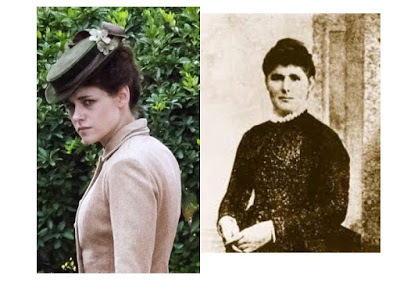 The real Bridget on the right, Kristen Stewart on the left
The real Bridget on the right, Kristen Stewart on the left1. She was restless.
Bridget moved to the U.S. from Ireland in 1886. For the next two years, she lived in three different states: Rhode Island, Pennsylvania and Massachusetts. Quite a lot of traveling for a young immigrant in her early 20s. Even within the small town of Fall River, Massachusetts, she worked for two other families before coming to be the Borden family maid in 1889.
2. She tried to quit.
Bridget was unhappy at the Borden household and tried several times to end her employment. It is said Mrs. Borden begged her to stay and raised her wages.
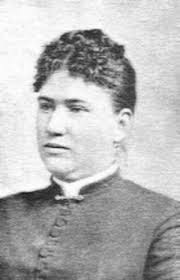 Abby welcomed Bridget's presence in the tense household
Abby welcomed Bridget's presence in the tense household3. She knew more than she said.
The prosecuting attorney Hosea Knowlton always thought Bridget had something to do with the murders, or at least had incriminating information she was holding back.
 Suspicious Hosea Knowlton
Suspicious Hosea Knowlton4. She had a strong brogue.
Bridget's Irish accent was so deep that at times during Lizzie Borden's trial she was not understood. In particular, when she spoke of "keys," it was thought she was saying "case."
5. She had a nickname
Whether Bridget welcomed it or not, Lizzie called her "Maggie," the name of a previous maid. Was it Lizzie being sloppy, finding it too darn difficult to learn a new name, or was she being affectionate? Was it meant to be demeaning? Bridget claimed in court that she didn't mind being called Maggie, but a person's name is one of the most profound and integral parts of their identity.
. . .Love history? My historical novels are below. And in October 2017, watch for The Murderer's Maid: a Novel of Lizzie Borden.

. . .
Published on January 11, 2017 12:58
December 31, 2016
Want a guide to help you write a better novel?
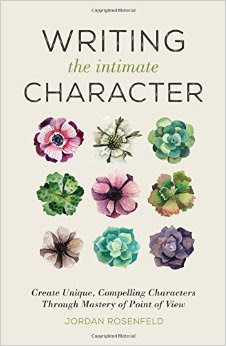 Isn't this cover design stunning? I wanted to let readers know of a wonderful book on the craft of writing, Jordan Rosenfeld'sWriting the Intimate Character: Creating Unique, Compelling Characters Through Mastery of Point of View. Out in October from Writer's Digest Books, the book includes incredible advice for writers, and I've been enjoying reading it because of its wit and incisiveness. It's inspiring, it spurs motion for writers, and delivers analysis of a tricky issue (point of view) that breaks it down into understandable components. Jordan and I did a quick interview over email and I'm happy to share it with you here. Q: You've had great success with your Writer's Digest books. What's thebest piece of feedback you got in response to one of them? Did anyone havea breakthrough or reach new understanding because of reading your words? Jordan: The two biggest compliments I've received are for Make a Scene and AWriter's Guide to Persistence. Several people have called Make a Scenetheir "writing bible" and many have said it has changed their understandingof scenes. However, I've been most moved by the comments on Persistence,like a 70 year old woman who heard me talk at a Writer's Digest conferenceand came to me, crying after, to say she had all but given up on herwriting and now she knew it wasn't too late, that she could still write forherself, no matter the outcome. Q: What's the best piece of advice in your latest book? Jordan: In Writing the Intimate Character, the best piece of advice is most likelyto remember that the best way to demonstrate all character experience, aswell as their point of view, is through sensory experiences: that is, howdo emotions and experiences feel in the body? Can you use all the senses,plus images, to show the reader fear, for example, as something writhing ina person's chest, rather than saying "he was mad." Q: Who do you think is the best audience for your latest book? Jordan: Absolutely anyone who wants a better understanding of point of view and howto develop strong characters. That's pretty much any writer, at any stage of development and experience. I found much to learn from with this book and highly recommend it! Jordan's had a fantastic career of teaching writing and writing craft books that distill her knowledge into fun and likeable books. Her voice is friendly and instructive, and draws you in. Jordan Rosenfeld is the author of seven books, most recently the novel Women in Red and the writing guide Writing the Intimate Character. Her freelance work has appeared in such places as The Atlantic, New York Times, Salon, Scientific American, The Washington Post and more.
Isn't this cover design stunning? I wanted to let readers know of a wonderful book on the craft of writing, Jordan Rosenfeld'sWriting the Intimate Character: Creating Unique, Compelling Characters Through Mastery of Point of View. Out in October from Writer's Digest Books, the book includes incredible advice for writers, and I've been enjoying reading it because of its wit and incisiveness. It's inspiring, it spurs motion for writers, and delivers analysis of a tricky issue (point of view) that breaks it down into understandable components. Jordan and I did a quick interview over email and I'm happy to share it with you here. Q: You've had great success with your Writer's Digest books. What's thebest piece of feedback you got in response to one of them? Did anyone havea breakthrough or reach new understanding because of reading your words? Jordan: The two biggest compliments I've received are for Make a Scene and AWriter's Guide to Persistence. Several people have called Make a Scenetheir "writing bible" and many have said it has changed their understandingof scenes. However, I've been most moved by the comments on Persistence,like a 70 year old woman who heard me talk at a Writer's Digest conferenceand came to me, crying after, to say she had all but given up on herwriting and now she knew it wasn't too late, that she could still write forherself, no matter the outcome. Q: What's the best piece of advice in your latest book? Jordan: In Writing the Intimate Character, the best piece of advice is most likelyto remember that the best way to demonstrate all character experience, aswell as their point of view, is through sensory experiences: that is, howdo emotions and experiences feel in the body? Can you use all the senses,plus images, to show the reader fear, for example, as something writhing ina person's chest, rather than saying "he was mad." Q: Who do you think is the best audience for your latest book? Jordan: Absolutely anyone who wants a better understanding of point of view and howto develop strong characters. That's pretty much any writer, at any stage of development and experience. I found much to learn from with this book and highly recommend it! Jordan's had a fantastic career of teaching writing and writing craft books that distill her knowledge into fun and likeable books. Her voice is friendly and instructive, and draws you in. Jordan Rosenfeld is the author of seven books, most recently the novel Women in Red and the writing guide Writing the Intimate Character. Her freelance work has appeared in such places as The Atlantic, New York Times, Salon, Scientific American, The Washington Post and more.Order Writing the Intimate Character by clicking on the image below. And: Happy New Year!
[image error] [image error]
Published on December 31, 2016 00:17
December 30, 2016
A diptych is worth 2,000 words
Here are the actors in the upcoming Lizzie Borden movie, paired with their historical counterparts.
Lizzie and Chloë Sevigny
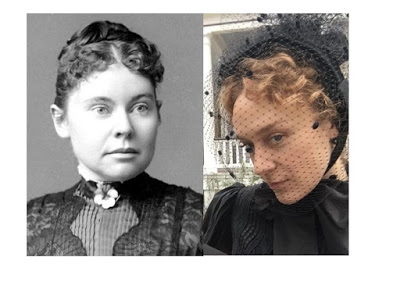
Bridget Sullivan (the Borden maid) and Kristen Stewart
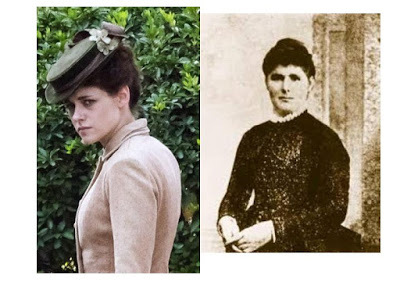
Abby Borden and Fiona Shaw
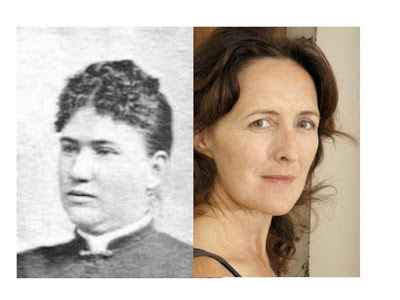
Andrew Borden and Jamey Sheridan

Another character I'm very keen on learning the actor for: Alice Russell. She was the friend Lizzie called for after the murders (rather than, oh say, the police).
And of course Emma her sister. Absent the day of the murders, she was sent a telegram that her father was very ill because it was thought the real news was too shocking to be delivered in that manner. Subsequently, she delayed returning to town until the evening, only to learn he had actually been hatcheted to death, and her stepmother too.
Welcome home.
. . . .
Lizzie and Chloë Sevigny

Bridget Sullivan (the Borden maid) and Kristen Stewart

Abby Borden and Fiona Shaw

Andrew Borden and Jamey Sheridan

Another character I'm very keen on learning the actor for: Alice Russell. She was the friend Lizzie called for after the murders (rather than, oh say, the police).
And of course Emma her sister. Absent the day of the murders, she was sent a telegram that her father was very ill because it was thought the real news was too shocking to be delivered in that manner. Subsequently, she delayed returning to town until the evening, only to learn he had actually been hatcheted to death, and her stepmother too.
Welcome home.
. . . .
Published on December 30, 2016 23:26
December 27, 2016
More about the Lizzie Borden movie
I understand filming wrapped before the holidays in Savannah, Georgia, and that the film is to be released "sometime in 2017." I for one cannot wait. Just the idea of sitting in a movie theater watching the trailer gets me all excited!
A few fun things to add: looking at a map of Fall River, Massachusetts (where the Borden murders took place), I saw that one of the streets leading to the cemetery where Lizzie and her family are buried is called Sevigny Street. Coincidence?? I've heard Chloe Sevigny--who plays Lizzie--has an interest/fascination in the story. Is it because relatives of hers lived in Fall River?
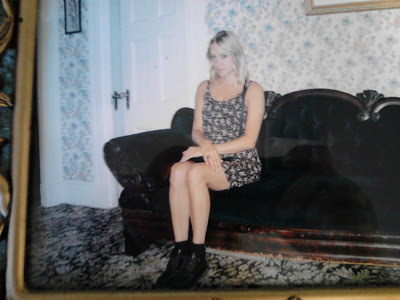 This photograph of Chloe sitting on the sofa (not the original, but very close to it visually) where Andrew Borden died can be found on the wall of the gift shop at the Lizzie Borden Bed & Breakfast. Whaaa....t? You didn't know the murder house is actually a themed B&B? It is. I stayed there last summer in the attic bedroom of Bridget Sullivan--the character whose point of view I chose for my novel The Murderer's Maid, coming out in October 2017--and will blog about that in detail later.
This photograph of Chloe sitting on the sofa (not the original, but very close to it visually) where Andrew Borden died can be found on the wall of the gift shop at the Lizzie Borden Bed & Breakfast. Whaaa....t? You didn't know the murder house is actually a themed B&B? It is. I stayed there last summer in the attic bedroom of Bridget Sullivan--the character whose point of view I chose for my novel The Murderer's Maid, coming out in October 2017--and will blog about that in detail later.
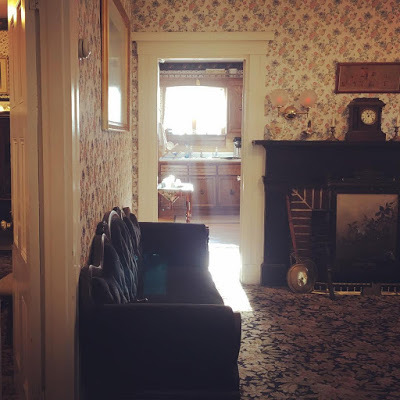
This picture of the movie set came from Twitter (#Lizziethemovie), and you can see how very closely the set conforms to the actual room. Or actually, maybe you can't because the photos are taken from two different angles. EPIPHANY: Okay, actually as I'm blogging, I'm realizing this MUST be a picture from the actual home, because in the distance you see faucets on the sink. That wouldn't be the case with a period set, but is indeed the case with the true house, because after the murders a series of real people lived in it and ate in it and required modern appliances.
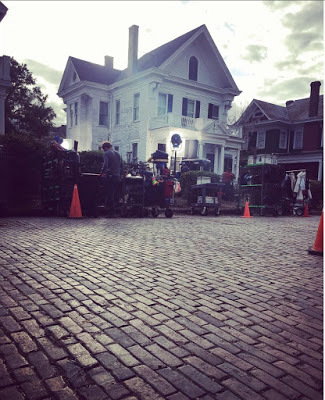
Okay, this one I know for SURE is the movie set, because it bears no resemblance to the actual house in Fall River.
 Photo by David on Flickr/Creative Commons
Photo by David on Flickr/Creative Commons
Here's the actual house in Fall River. What's interesting to me is that the movie house is far more grand, because the family's money (wealthy) and Lizzie's access to it (restricted) forms quite a bit of a murder motive. Lizzie desperately wanted to be successful in society, hold grand parties, entertain...but her father wouldn't let her, and the house was in a part of town looked down upon (literally) by fancier hills residents.
Next door even lived Irish people (shudder!), who were considered low-class at the time. After Andrew Borden's body was discovered, the Irish maid Bridget was sent to fetch Dr. Bowen across the street....because every clearly-mutilated corpse deserves to have its absent pulse noted....when he wasn't there, instead of getting Dr. Kelly who was right next door, Lizzie instead sent Bridget to get her friend. Why not Dr. Kelly? He was Irish. And why no police? Because she was guilty. ;)
Speaking of Bridget, she's played in the movie by Kristen Stewart. She's a fantastic choice, and I can't wait to hear if her Irish accent is an authentic brogue. Stewart is 26 years old, as was Bridget at the time of the murders. Kismet? Interestingly, I just reread a section of the trial transcripts where Bridget reveals she doesn't know when her birthday is. How strange that is...so much of our identity is wrapped up in our births and celebrating that day. Maybe I'll invent a birthday for Bridget and start celebrating it in some weird way.
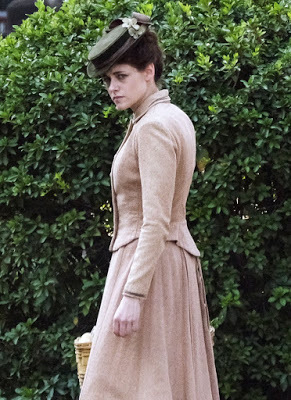 Kristen Stewart on set as Bridget Sullivan, Lizzie's maid
Kristen Stewart on set as Bridget Sullivan, Lizzie's maid
Lizzie was 32 at the time of the murders, and Chloe is 42, but of course Lizzie didn't have access to wonderful aesthetician creams, so looks far older than lovely Chloe.
Let's see...I also saw a photograph of a seaside home on the Twitter page, which excited me because it looks like this movie is trying to cover the historically-accurate bases.

This could be a photo of the seaside cottage at Marion, a trip Lizzie was supposed to take with her girlfriends--and instead was at home on a hot August day when her father and stepmother were murdered. More likely, however, it's a picture of the Swansea home, where she and her family vacationed. It was a meaningful house sentimentally, but there is evidence that her father was about to sell it, putting it in her stepmother's name, just days before the murders. A previous example of Mr. Borden putting a home in his wife's name led to incredible angst within the household--so angsty that Lizzie stopped calling her stepmother "Mother," as she had done for nearly three decades, and instead called her Mrs. Borden until the time of her death. So: motive motive motive. Kudos to the filmmakers for getting this right. I can't wait to read the script sometime.
And of course...watch the movie.
I'll continue to blog about Lizzie Borden and anything I hear about the movie in progress. Please follow my blog if you want more updates; see the sign-up in the right hand column when you scroll down.
. . . .
A few fun things to add: looking at a map of Fall River, Massachusetts (where the Borden murders took place), I saw that one of the streets leading to the cemetery where Lizzie and her family are buried is called Sevigny Street. Coincidence?? I've heard Chloe Sevigny--who plays Lizzie--has an interest/fascination in the story. Is it because relatives of hers lived in Fall River?
 This photograph of Chloe sitting on the sofa (not the original, but very close to it visually) where Andrew Borden died can be found on the wall of the gift shop at the Lizzie Borden Bed & Breakfast. Whaaa....t? You didn't know the murder house is actually a themed B&B? It is. I stayed there last summer in the attic bedroom of Bridget Sullivan--the character whose point of view I chose for my novel The Murderer's Maid, coming out in October 2017--and will blog about that in detail later.
This photograph of Chloe sitting on the sofa (not the original, but very close to it visually) where Andrew Borden died can be found on the wall of the gift shop at the Lizzie Borden Bed & Breakfast. Whaaa....t? You didn't know the murder house is actually a themed B&B? It is. I stayed there last summer in the attic bedroom of Bridget Sullivan--the character whose point of view I chose for my novel The Murderer's Maid, coming out in October 2017--and will blog about that in detail later.
This picture of the movie set came from Twitter (#Lizziethemovie), and you can see how very closely the set conforms to the actual room. Or actually, maybe you can't because the photos are taken from two different angles. EPIPHANY: Okay, actually as I'm blogging, I'm realizing this MUST be a picture from the actual home, because in the distance you see faucets on the sink. That wouldn't be the case with a period set, but is indeed the case with the true house, because after the murders a series of real people lived in it and ate in it and required modern appliances.

Okay, this one I know for SURE is the movie set, because it bears no resemblance to the actual house in Fall River.
 Photo by David on Flickr/Creative Commons
Photo by David on Flickr/Creative CommonsHere's the actual house in Fall River. What's interesting to me is that the movie house is far more grand, because the family's money (wealthy) and Lizzie's access to it (restricted) forms quite a bit of a murder motive. Lizzie desperately wanted to be successful in society, hold grand parties, entertain...but her father wouldn't let her, and the house was in a part of town looked down upon (literally) by fancier hills residents.
Next door even lived Irish people (shudder!), who were considered low-class at the time. After Andrew Borden's body was discovered, the Irish maid Bridget was sent to fetch Dr. Bowen across the street....because every clearly-mutilated corpse deserves to have its absent pulse noted....when he wasn't there, instead of getting Dr. Kelly who was right next door, Lizzie instead sent Bridget to get her friend. Why not Dr. Kelly? He was Irish. And why no police? Because she was guilty. ;)
Speaking of Bridget, she's played in the movie by Kristen Stewart. She's a fantastic choice, and I can't wait to hear if her Irish accent is an authentic brogue. Stewart is 26 years old, as was Bridget at the time of the murders. Kismet? Interestingly, I just reread a section of the trial transcripts where Bridget reveals she doesn't know when her birthday is. How strange that is...so much of our identity is wrapped up in our births and celebrating that day. Maybe I'll invent a birthday for Bridget and start celebrating it in some weird way.
 Kristen Stewart on set as Bridget Sullivan, Lizzie's maid
Kristen Stewart on set as Bridget Sullivan, Lizzie's maidLizzie was 32 at the time of the murders, and Chloe is 42, but of course Lizzie didn't have access to wonderful aesthetician creams, so looks far older than lovely Chloe.
Let's see...I also saw a photograph of a seaside home on the Twitter page, which excited me because it looks like this movie is trying to cover the historically-accurate bases.

This could be a photo of the seaside cottage at Marion, a trip Lizzie was supposed to take with her girlfriends--and instead was at home on a hot August day when her father and stepmother were murdered. More likely, however, it's a picture of the Swansea home, where she and her family vacationed. It was a meaningful house sentimentally, but there is evidence that her father was about to sell it, putting it in her stepmother's name, just days before the murders. A previous example of Mr. Borden putting a home in his wife's name led to incredible angst within the household--so angsty that Lizzie stopped calling her stepmother "Mother," as she had done for nearly three decades, and instead called her Mrs. Borden until the time of her death. So: motive motive motive. Kudos to the filmmakers for getting this right. I can't wait to read the script sometime.
And of course...watch the movie.
I'll continue to blog about Lizzie Borden and anything I hear about the movie in progress. Please follow my blog if you want more updates; see the sign-up in the right hand column when you scroll down.
. . . .
Published on December 27, 2016 23:11
December 11, 2016
The Harry Potter-Lizzie Borden connection
 Fiona Shaw
Fiona ShawIt's not the Bertie Botts Every Flavour Beans, although we know Lizzie did enjoy the many candies sent to her in jail as she awaited trial.
 The real Abby Borden
The real Abby BordenNo, the connection is that while the Lizzie Borden movie is filming in Savannah, Georgia, Daniel Radcliffe is in town filming something else AND I just learned that Fiona Shaw, who played Harry Potter's cruel Aunt Petunia, will portray Abby Borden.
Yes, she is Lizzie's stepmother, who will be brutally murdered.
Abby Borden was said to be very stout, at 180 pounds, so lovely slim Fiona will have to eat more of those beans. She was also 64 at the time of her murder. Ah well, Hollywood is fun in that it "adjusts" things for us. Maybe Shaw's Abby will fight back and grab the hatchet and chase the killer down Second Street.
The family maid, Bridget Sullivan, said a few weeks after the murders that Abby "was treated badly by Lizzie and [her sister] Emma...and particularly by Lizzie." She said that Abby "was too good for them and they did not like her."
Abby had been stepmother to the two girls since Emma was 14 and Lizzie a mere five. In fact, up until just a few years before the murders, the middle-aged Lizzie called Abby "Mother." A money-based dispute led to her suddenly calling her Mrs. Borden instead.
Bridget reported that the sisters never ate meals with the elder Bordens; it was a household divided. And on a hot August morning, someone was pushed too far, and blood was spilled.
. . . .
Published on December 11, 2016 23:01
December 10, 2016
Timberline's true name
For those of you coming to this blog because of the Book Bub promotion, I wanted to repost something about the woman depicted on the cover of Woman of Ill Fame.

Timberline's True Name
--This is a reposting; I know there is renewed interest in Woman of Ill Fame and so I'm going to put this blog post up again.
This blog is currently about witchcraft persecutions, ancient and modern, but now and then I will dip into material regarding my first novel Woman of Ill Fame. The novel is about a Gold Rush prostitute in a dangerous, brand-new San Francisco.
A few days ago, someone was in my archives and saw my post about the real-life prostitute whose image is featured on the cover. All I knew was that her name was Timberline, she was a Dodge City prostitute, and her image is in the collections of the Kansas State Historical Society.
Well, the anonymous commenter wrote that her name was Rose Vastine.
That for one thing totally threw me. Although I fashioned my character based on this photograph and named her Nora, for some reason I had “felt” that this real woman’s name was Kate.
Secondly, the commenter wrote that she earned the name Timberline for being 6’2” in height. Another big surprise. In my mind, the nickname had dirty connotations!
Armed with her real name, I consulted Professor Google.
The first link I accessed made me gasp out loud in the café I was working in, and literally grab my forehead. According to Linda Wommack’s Ladies of the Tenderloin, “Timberline climbed up into the hills above Creede and shot herself not once, but six times.”
When you have spent so much time staring at someone’s photograph and constructing an entire novel around them, you develop a strange and intense connection to them. It was almost as upsetting as hearing this news about someone I knew…but not only was Timberline a stranger to me, but she died 150 years ago. Whatever sorrows she endured, they are dust now.
I had dedicated the novel to two wonderful women the world lost at an early age, and on the second line dedicated it to “Timberline and the other girls of the line: I hope the world was kind to you.”
And here was evidence that the world had not been kind to her.
The link went on to say that Timberline did not die from that suicide attempt, but strangely enough, another link had her recovering from an “intended overdose.” Is it apocryphal that she tried to kill herself with such vastly different methods and survived both times? Whatever the truth is, she must have been an unhappy young woman.
Several sources have her living in Creede, Colorado, a silver mining camp 420 miles from the Dodge City that her photograph is labeled with. Sure enough, the website for Creede, Colorado mentions Timberline on its “About Creede” page. Bat Masterson too (whose biography the commenter mentions) lived in both cities, so maybe she hitched a ride with him.
If anyone has any more information on her, I’d most definitely love to know it.
. . . . .

Timberline's True Name
--This is a reposting; I know there is renewed interest in Woman of Ill Fame and so I'm going to put this blog post up again.
This blog is currently about witchcraft persecutions, ancient and modern, but now and then I will dip into material regarding my first novel Woman of Ill Fame. The novel is about a Gold Rush prostitute in a dangerous, brand-new San Francisco.
A few days ago, someone was in my archives and saw my post about the real-life prostitute whose image is featured on the cover. All I knew was that her name was Timberline, she was a Dodge City prostitute, and her image is in the collections of the Kansas State Historical Society.
Well, the anonymous commenter wrote that her name was Rose Vastine.
That for one thing totally threw me. Although I fashioned my character based on this photograph and named her Nora, for some reason I had “felt” that this real woman’s name was Kate.
Secondly, the commenter wrote that she earned the name Timberline for being 6’2” in height. Another big surprise. In my mind, the nickname had dirty connotations!
Armed with her real name, I consulted Professor Google.
The first link I accessed made me gasp out loud in the café I was working in, and literally grab my forehead. According to Linda Wommack’s Ladies of the Tenderloin, “Timberline climbed up into the hills above Creede and shot herself not once, but six times.”
When you have spent so much time staring at someone’s photograph and constructing an entire novel around them, you develop a strange and intense connection to them. It was almost as upsetting as hearing this news about someone I knew…but not only was Timberline a stranger to me, but she died 150 years ago. Whatever sorrows she endured, they are dust now.
I had dedicated the novel to two wonderful women the world lost at an early age, and on the second line dedicated it to “Timberline and the other girls of the line: I hope the world was kind to you.”
And here was evidence that the world had not been kind to her.
The link went on to say that Timberline did not die from that suicide attempt, but strangely enough, another link had her recovering from an “intended overdose.” Is it apocryphal that she tried to kill herself with such vastly different methods and survived both times? Whatever the truth is, she must have been an unhappy young woman.
Several sources have her living in Creede, Colorado, a silver mining camp 420 miles from the Dodge City that her photograph is labeled with. Sure enough, the website for Creede, Colorado mentions Timberline on its “About Creede” page. Bat Masterson too (whose biography the commenter mentions) lived in both cities, so maybe she hitched a ride with him.
If anyone has any more information on her, I’d most definitely love to know it.
. . . . .
Published on December 10, 2016 09:55



